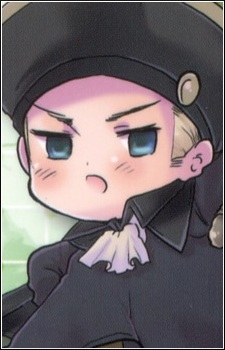
| Original Name (Japanese) | 神聖ローマ |
|---|---|
| Romaji Name | Shinsei Rōma |
| Nicknames | Holy Rome |
| Series | Hetalia Axis Powers |
| Age | Unknown (appears as a child) |
| Weight | Unknown |
| Height | Approximately 90cm (3 feet) |
| Date of Birth | Unknown |
| Blood Type | Unknown |
Personality
In the Hetalia Axis Powers series, the Holy Roman Empire is portrayed as short-tempered, but kind when he wants to be. He is deeply in love with Italy, whose refusal to form a new Roman Empire with him is said to have contributed to the crumbling of his own empire. Despite his strong nature, Holy Rome is portrayed as having an extremely weak constitution.
Background
The Holy Roman Empire is the grandson of Germania in the Hetalia universe. He lived for a time with Austria, Hungary, and the young Italy (referred to as “Chibitalia”). During this time, he made the decision to try to get Italy to join him in forming a new Roman Empire. However, Italy refused, fearing that Holy Rome would end up defeated and mortally wounded like his grandfather. After entering the Thirty Years’ War, Holy Rome disappeared and is believed to have died.
Appearance
According to creator Hidekaz Himaruya, Holy Roman Empire’s height (as well as Chibitalia’s) was revealed to be 7 apples tall, which is about 90cm or 3 feet. In the English dub of the anime, he was given an Italian accent, though this was historically inaccurate as he was of Germanic descent.
Abilities
The Holy Roman Empire is described as being quite strong, but he lacked any sense of artistic ability. He was, however, very intelligent, and Austria made him study extensively.
Origin
In the Hetalia Axis Powers series, the Holy Roman Empire is the successor state to the historical Holy Roman Empire, which was a complex political entity that existed in Central Europe during the Middle Ages and early modern period, usually headed by the Holy Roman Emperor.
Holy Roman Empire – FAQ
Here are 6-8 FAQs about the Holy Roman Empire from the anime “Hetalia Axis Powers”:
What is the Holy Roman Empire?
The Holy Roman Empire was a political entity that existed in Central Europe during the Middle Ages and Early Modern Times. It was not a single nation-state, but rather a confederation of territories ruled by an emperor who was considered the successor to the Roman Emperors.
Who was the personification of the Holy Roman Empire in Hetalia?
In the Hetalia universe, the Holy Roman Empire was personified as a young, blond-haired boy who was often depicted as quiet and introverted. He was considered a sibling or close friend of the character representing Germany.
What was the relationship between the Holy Roman Empire and the other Hetalia characters?
The Holy Roman Empire was shown to have a close relationship with Austria, who often took care of him. It was also friendly with Italy, although their relationship was complicated by Italy’s desire for independence. The Holy Roman Empire was often overshadowed by the larger powers of the time, such as France and Prussia.
What happened to the Holy Roman Empire in the history of Hetalia?
In the Hetalia universe, the Holy Roman Empire was dissolved in 1806, and its territories became part of the Austrian Empire and the German Confederation. This event was depicted as traumatic for the personified Holy Roman Empire, which disappeared and was presumed dead.
How did the dissolution of the Holy Roman Empire affect the other Hetalia characters?
The dissolution of the Holy Roman Empire had a significant impact on the other Hetalia characters, especially Germany and Italy. Germany was shown to carry on the legacy of the Holy Roman Empire, while Italy struggled with the loss of a close friend and ally.
What was the role of the Holy Roman Empire in the larger Hetalia story?
The Holy Roman Empire played an important role in the Hetalia universe as a representation of the complex political and cultural dynamics of the time. Its dissolution and the subsequent rise of Germany and other modern nation-states were key events that shaped the course of European history.


